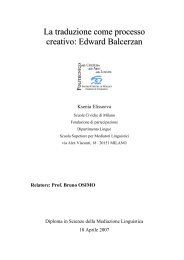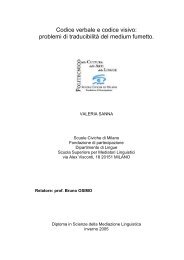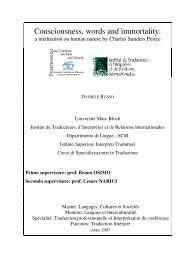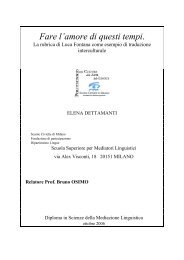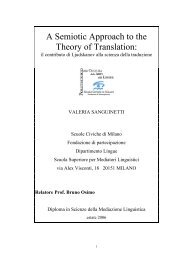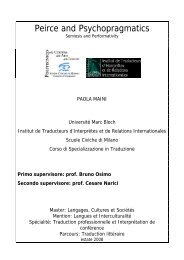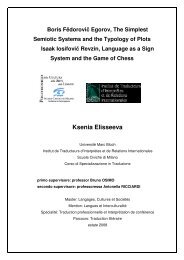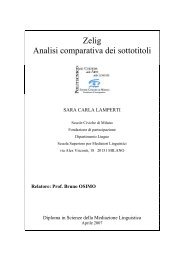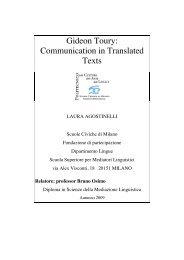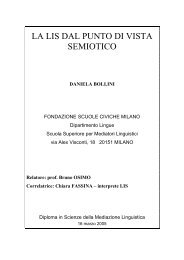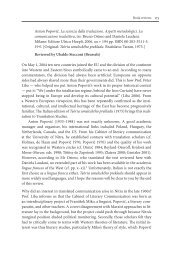Alice in Wonderland - Bruno Osimo, traduzioni, semiotica della ...
Alice in Wonderland - Bruno Osimo, traduzioni, semiotica della ...
Alice in Wonderland - Bruno Osimo, traduzioni, semiotica della ...
Create successful ePaper yourself
Turn your PDF publications into a flip-book with our unique Google optimized e-Paper software.
3. Some Translation Problems Connected with Proper<br />
Names<br />
In spite of the “translation rule” quoted above, there are no rules for the<br />
translation of proper names. In non-fictional texts, it seems to be a<br />
convention to use the target-culture exonym of a source-culture name, if<br />
there is one, but if a translator prefers to use the source-culture form,<br />
nobody will m<strong>in</strong>d as long as it is clear what place the name refers to.<br />
Perhaps the audience will th<strong>in</strong>k that the translator is show<strong>in</strong>g off her<br />
knowledge too much. Wherever the function of the proper name is limited<br />
to identify<strong>in</strong>g an <strong>in</strong>dividual referent, the ma<strong>in</strong> criterion for translation will be<br />
to make this identify<strong>in</strong>g function work for the target audience.<br />
In fiction, th<strong>in</strong>gs are not quite as simple as that. We have assumed<br />
that <strong>in</strong> fictional texts there is no name that has no <strong>in</strong>formative function at<br />
all, however subtle it may be. If this <strong>in</strong>formation is explicit, as <strong>in</strong> a<br />
descriptive name, it can be translated – although a translation may <strong>in</strong>terfere<br />
with the function of culture marker. If the <strong>in</strong>formation is implicit, however,<br />
or if the marker function has priority over the <strong>in</strong>formative function of the<br />
proper name, this aspect will be lost <strong>in</strong> the translation, unless the translator<br />
decides to compensate for the loss by provid<strong>in</strong>g the <strong>in</strong>formation <strong>in</strong> the<br />
context.<br />
Of course, there are proper names that exist <strong>in</strong> the same form both <strong>in</strong><br />
the source and the target culture. But this causes other problems: The<br />
character changes “nationality” just because the name is pronounced <strong>in</strong> a<br />
different way. An English Richard thus turns <strong>in</strong>to a German Richard, and a<br />
French Robert <strong>in</strong>to an English Robert – which may <strong>in</strong>terfere with the<br />
homogeneity of the sett<strong>in</strong>g if some names are “bicultural” and others are<br />
not. For example: In a little comic strip I translated with my students <strong>in</strong> the<br />
Spanish-German translation class, the two characters, brothers, are called<br />
Miguelito and Hugo (cf. Nord 2001: 58ff.). If we leave the names as they<br />
are, Miguelito will be clearly recognizable as a Spanish boy <strong>in</strong> the translation,<br />
33



